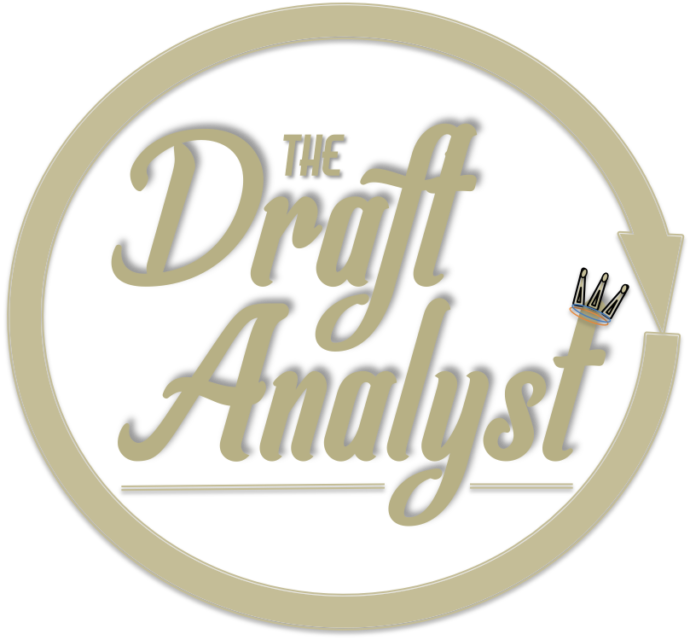Enter Player
2020 Draft: Top 10 Russian Prospects
Steve Kournianos | 3/18/2020 | Nashville | [hupso]
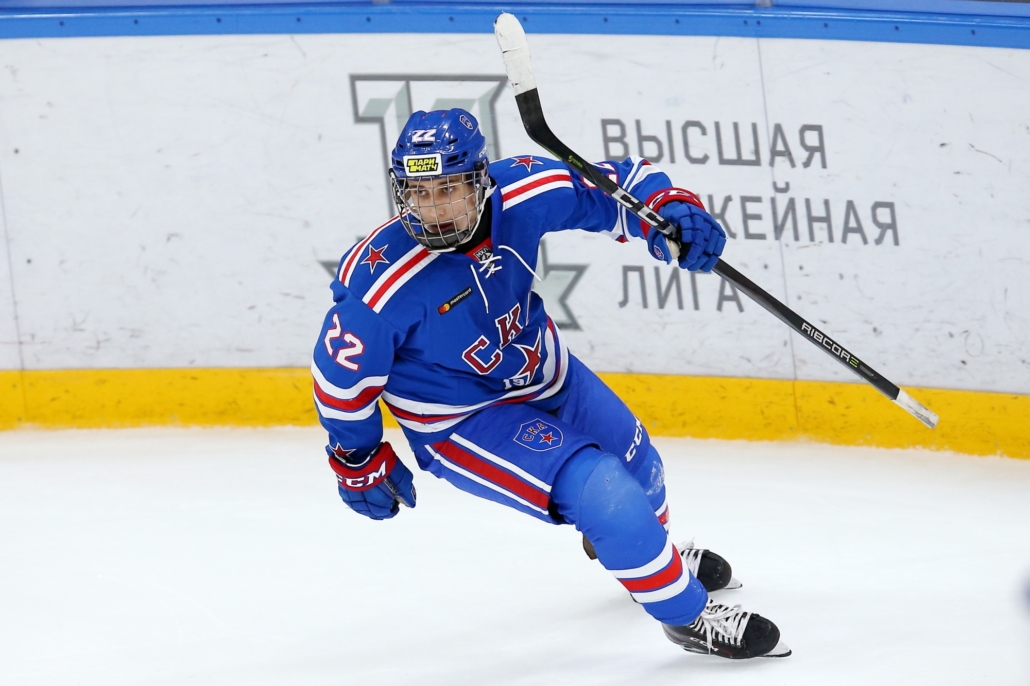
NASHVILLE (The Draft Analyst) — When it comes to the NHL draft, there’s a different standard for most organizations when it comes to evaluating and ultimately selecting Russian prospects. Unless they are playing in a North American junior league such as the Canadian Hockey League or United States Hockey League, Russian-trained draft eligibles are generally off limits in the first round of the draft, and some teams avoid drafting them altogether. Some say the lure of the KHL and taking in a good salary while playing closer to home makes it tougher to persuade Russian prospects to cross the pond and play in North America; a belief that has been somewhat debunked by the keen salesmanship of the front offices of pro-Russian teams like the New York Rangers.
Nonetheless, the late-2001/2002 year group is one of Russia’s best in several years, and gold medals at their World U17 Hockey Challenge, under-18 Ivan Hlinka, and under-20 World Junior “A” Challenge validate that claim. Although the group is heavy on forwards and thin on defensemen, teams like the Anaheim Ducks and Ottawa Senators may need to rethink their seemingly anti-Russian draft tactics whenever the 2020 draft is held, and below are 10 of the best prospects the Russians have to offer this year.
1. Rodion Amirov
Right Wing | Tolpar, MHL | 6’0, 167 | 10/2/01 | Shoots Left | 17gp-10g-12a-22pts

The total package when it comes to puck possession and dominating zone time on offense, Amirov is the crown jewel of an excellent Russian draft class. He spent most of the first half with the KHL’s Salavat Ufa squad — a rarity for first-year draft eligibles — and also stood out for Team Russia during the November Super Series versus the Canadian Hockey League’s All-Star team. Amirov’s strong in so many categories related to both sides of the rink, he’d likely be in the running for the top three of the 2020 draft had he been given more attention; especially after the way he torched the MHL in the second half.
Amriov is an elite stickhandler and is incredibly reliable when entering the opposing zone. He cleans up a lot of mistakes for his teammates and quickly transitions into attack mode. Amirov owns an excellent shot-release combination and fires pucks off the pass as accurately as any forward within his peer group. Powerful on his skates and elusive in traffic, he is all but guaranteed to be the first Russian skater taken at the draft.
For a more detailed scouting report and video highlights, click here.
2. Marat Khusnutdinov
Center | SKA-1946, MHL | 5’11, 176 | 7/17/02 | Shoots Left | 44gp-13g-25a-38pts

Khusnutdinov may have a long last name that’s look difficult to pronounce (it’s Koos-new-dee-nov), but the results he produces on the ice are quick, effortless, and practically impossible to forget. He’s played off the top line of a powerful SKA-1946 team but still managed to average nearly a point a game despite rarely seeing the bulk of offensive-zone starts and time on the first power-play unit. Khusnutdinov also represented Russia on the international stage with impressive showings at the under-20 World Junior “A” Challenge, and the under-18 Five Nations and Ivan Hlinka tournaments.
Unlike Amirov’s workmanlike approach, Khusnutdinov is a flashy and excitable player, albeit one who also pays attention to his defensive-zone responsibilities. He can beat you with his speed inside or outside, but also battle hard along the boards before slipping undetected into a soft area near the goal. Khusnutdinov is a natural center who can be an effective playmaker and also win the majority of his draws.
For a more detailed scouting report and video highlights, click here.
3. Yaroslav Askarov
Goalie | SKA-Neva, VHL | 6’3, 176 | 6/16/02 | Catches Right | 12-3-3, 2.45 GAA, .920 Save %
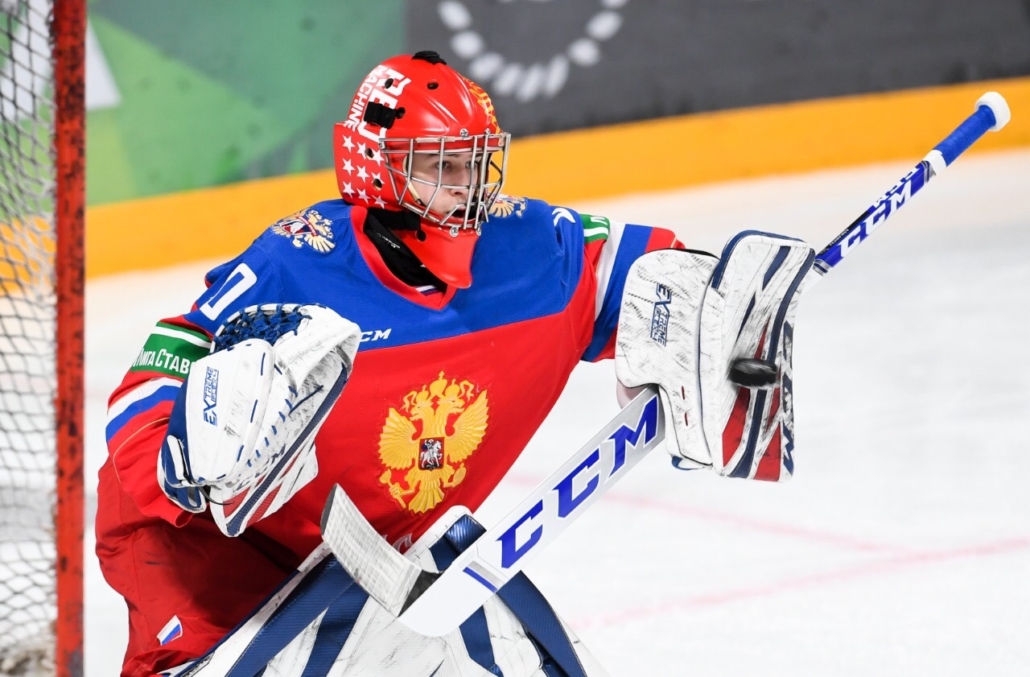
The most heralded goaltending prospect since Carey Price some 15 years ago has had an up-and-down draft year, but the fact still remains — no netminder in this draft has shown the potential for stardom the way Askarov has.
For starters, the 17-year-old backstop was the youngest goalie in VHL history to appear in more than nine games. In fact, Askarov shared duties with 1998-born backstop Alexei Melnichuk. In November, Askarov became the youngest goalie in KHL history to record a win, which he registered after a 23-save effort against Sochi. And all this was after he stonewalled one of the strongest Canadian entries in recent memory in the gold medal game at the under-18 Ivan Hlinka Memorial Cup last August. Last season, Askarov out-dueled American prodigy Spencer Knight several times and led Russia to within a goal of the IIHF under-18 world championship, and that was after he won gold at the World under-17 Hockey Challenge.
As you can see, Askarov’s pre-draft resume is stellar, even if his showing at the last under-20 world junior championship (2-2-0, .876 save percentage) was more disconcerting than it was promising. But again, the fact that Askarov at 17 was entrusted with leading Russia in a tournament they always reserve for 18 or 19-year-olds speaks more about his potential than the actual games themselves. Goalies, moreso than any other prospects, have steeper learning curves, and those rewarded with playing time against adults or older competition should not be punished. Especially if they’ve proven to dominate their own age group.
From a technical standpoint, Askarov’s style draws a lot of attention. Not only does he catch with his right hand, but he remains perfectly upright throughout his shuffling with his stick blade on the ice and his head totally locked into puck movement. To some, this may seem nonchalant or overconfident, but Askarov can snap into a textbook butterfly ready stance in an instant when facing a shooter. He will challenge shooters above the paint, but losing the net is something he’s shown to do from time to time. When he gets beat, however, it usually takes a labeled shot with a clear line of sight. If he can fine-tune his net awareness and be more consistent playing the appropriate depth in relation to shooting angles, then the cliche criticisms that focus on his glove-hand positioning would be rendered moot. Especially when his lower-half coverage, strong and controlled lateral pushes, and acute awareness make high-danger and second-chance opportunities almost impossible.
More Askarov #2020NHLDraft pic.twitter.com/w2Tem7tvfq
— Steve Kournianos (@TheDraftAnalyst) November 8, 2019
4. Vasily Ponomaryov
Center | Shawinigan, QMJHL | 5’10, 180 | 3/13/02 | Shoots Left | 57gp-18g-31a-49pts
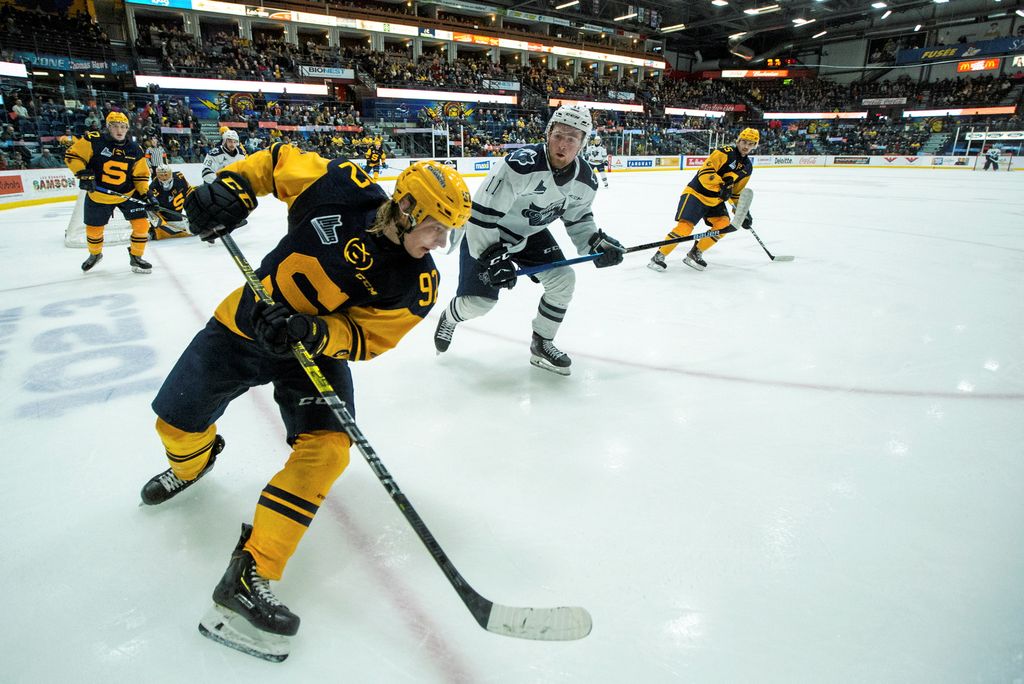
A two-way center who can fill many roles, Ponomaryov was one of the top rookies in the QMJHL and a key contributor to a rebuilding Shawinigan squad. After impressive showings in international tournaments such as the 2019 World U17 Hockey Challenge and the U18 Ivan Hlinka last August, Ponomaryov transitioned to North American for his draft year and made an immediate impact, picking up at least one point in 20 of his first 27 games.
Ponomaryov is a strong stickhandler with multiple fakes and spin moves that he times with precision, both in open ice and tight spaces. He’s a possession driver with very good speed and excellent balance, and much like Amirov, he can create chances using crisp cross-ice passes — forehand or backhand — while operating off the cycle. An under-appreciated aspect of Ponomaryov’s game is his dedication to backchecking and defensive-zone positioning, and you rarely see him allow the low slot to be vacated. He is used as on the lead power-play unit and centers the first group on the penalty kill.
There is a significant degree of flash and pizzazz to Ponomaryov’s game. Not only is he capable of creating highlight-reel plays with his vision and passion, but he is very slippery and as he maneuvers towards the goal. He has a strong lower body and knows how to shield the puck, but defenders need to be cognizant of Ponomaryov’s ability to make a rapid gear shift or sharp cut to the inside while remaining in control on the puck. Once he’s in that danger area in the middle of the ice, goalies need to be on their toes, as Ponomaryov can blister shots from above the hash marks and label them inside either post or towards the upper half.
The most impressive aspect of his season beyond his production and tournament play was how he handled his expanded role as a top-line center once fellow 2020 draft hopeful and leading scorer Mavrik Bourque went down with an injury. He was playing over 20 minutes a night and helped the Cataractes post a respectable 6-6-1 mark without their best player. There’s also a fearlessness in his game, as Ponomaryov is not only willing to battle and stand up to bigger opponents, but also bounce right back up when he’s hammered into the boards.
#WJAC: Canada-East hit iron in OT then took a GI penalty that proves costly. C Vasily Ponomaryov fires a bullet from 50 feet out to give Russia a 3-2 win over Canada-East in the tournament opener. Really fun game to watch and gave you a bit of everything. Canadians hung tough. pic.twitter.com/ojOWr7uyRl
— Steve Kournianos (@TheDraftAnalyst) December 7, 2019
5. Daniil Guschin
Right Wing | Muskegon, USHL | 5’8, 165 | 2/6/02 | Shoots Left | 42gp-22g-25a-47pts
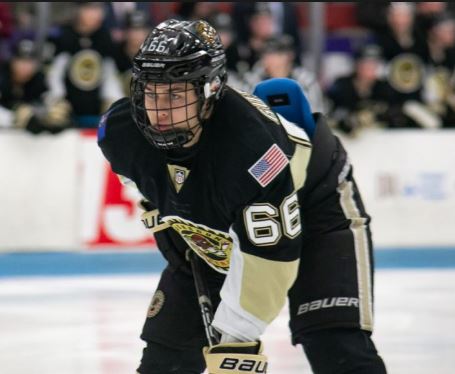
A hound in all three zones who is one of the more excitable players you’ll find in his draft class, Gushchin has spent the last two seasons in the USHL and it clearly shows in the way he competes hard and plays physical. Intelligent on or off the puck, Gushchin contributes on special teams and in late/close situations. He routinely is summoned for big penalty kills and will treat the on-ice disadvantage as an opportunity to make life a living hell for the other side. He is a very fast skater with multi-directional quickness, but Gushchin stays disciplined by keeping his stick and body positioned properly without cheating himself.
Guschin is a high-volume shooter who cannot be taken lightly no matter how calm or deliberate he appears as he enters the opposing zone. His 182 shots were third in the USHL and almost double from last year’s total and in less games. Even more impressive about Gushchin’s USHL stats — 42 of his 47 points (87 percent) were at even strength or shorthanded, the best percentage of any USHL Top-30 scorer.
On the puck, Gushchin shows impressive skills and decision-making both within the attacking zone and on the rush. His passes are delivered with confidence, accuracy, and authority, and it is a common occurrence to see defenders backing in way too deep and affording him too much time and space to exploit. A reason for this is Gushchin’s speed and trickery, and he’s been in the USHL long enough for opposing coaches to acknowledge his elusiveness when faced with a defender stepping up. Like several other Russian first-year eligibles listed under six feet tall, Gushchin plays bigger than his measurements and is very difficult to knock off the puck.
The most impressive weapon in Gushchin’s arsenal is his shot. He can score from varying distances and doesn’t need optimal shooting conditions to make goalies earn each save. Gushchin is an excellent skater, but he can also label wrist shots off the rush with accuracy. It seems like Gushchin doesn’t try score with every shot he takes, but that speaks more to his hockey sense than his confidence in his shot — he will unload a heavy wrister or slapper from bad angles knowing the goalie will kick that rebound right into the open slot for a linemate to pounce on.
#WJAC: Slippery Muskegon winger Daniil Guschin makes it look easy after a nice play by Shakir Mukhamadullin. Russia leads Canada-East 2-1 in the 3rd pic.twitter.com/oaJDU53GAJ
— Steve Kournianos (@TheDraftAnalyst) December 7, 2019
6. Shakir Mukhamadullin
Defense | Salavat Ufa, KHL | 6’4, 178 | 1/10/02 | Shoots Left | 27gp-0g-1a-1pt
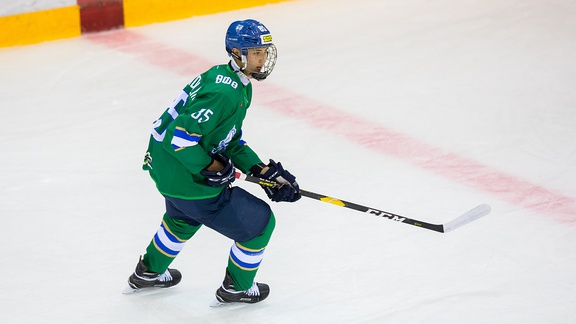
A physical presence on Russia’s blueline at multiple under-20 events, Mukhamadullin is a crease clearer and one-on-one eraser who held his own against premier competition with Ufa of the KHL. You can make a strong argument that he’s the most polished of any draft-eligible defenseman from a quality of competition standpoint, and boosting this value is his multi-situational versatility. How so? When he played against those in his age group in the tight-checking MHL, Mukhamadullin recorded 13 points in 18 games for a 0.72 points-per-game average — the second-highest rate for defensemen in league history. Mukhamadullin also plays as a top penalty killer, shutdown defender, and can quarterback a power play. He also plays over 20 minutes a game and owns one of the hardest shots in the draft while hitting the net with consistency.
Mukhamadullin is a big, rangy defender who oozes top-pairing potential. Not only for his size and booming shot, but also for his poise under pressure and a quick-strike mentality when opposing teams try to establish superiority in a dump-and-chase environment. Mukhamadullin is very crafty during retrievals and his stretch-pass proclivity puts aggressive forecheckers on notice. Although his home-run passes can stretch out defenses, his impressive skating ability under pressure centered on delays, sharp cut-backs, and gear shifting to outpace quick forecheckers. On multiple occasions with Team Russia, Mukhamadullin was counted on to play a centralized role on the power play, and the leading playmaking forwards such as Marat Khusnutdinov and Vasily Ponomaryov consistently looked to set him up for one-timers.
On the defensive side, Mukhamdullin is a physical crease clearer who uses his stick to send a message. He’s played against quicker, older teams in the past, so don’t bet on him being intimidated by the best of his draft-age peers. If anything, they have to prepare for him, especially if they want to mitigate Mukhamadullin’s strong blue line presence and textbook stick-on-puck techniques. He is very quick to the puck and makes timely step-ups and reads, and when the situation presents itself, Mukhamadullin will take the puck for a skate and drive the net with confidence. Like most young defensemen in a lead role, Mukhamadullin can be guilty of trying to tackle every problem on his own, albeit with good intentions. There’s nothing too “raw” about him but a few adjustments is all he needs to become on the top defensemen Russia has produced in several draft classes
Here’s your golden goal … Shakhir Mukhamadullin with an absolute rocket off a #CANEast🇨🇦 body in the high slot to win it for 🇷🇺. #WJAC 🥇 pic.twitter.com/aOcNBcdBGx
— World Junior A Challenge (@HC_WJAC) December 16, 2019
7. Pavel Tyutnev
Wing/Center | Loko Yaroslavl, MHL | 5’10, 185 | 7/25/02 | Shoots Left | 36gp-13g-9a-22pts
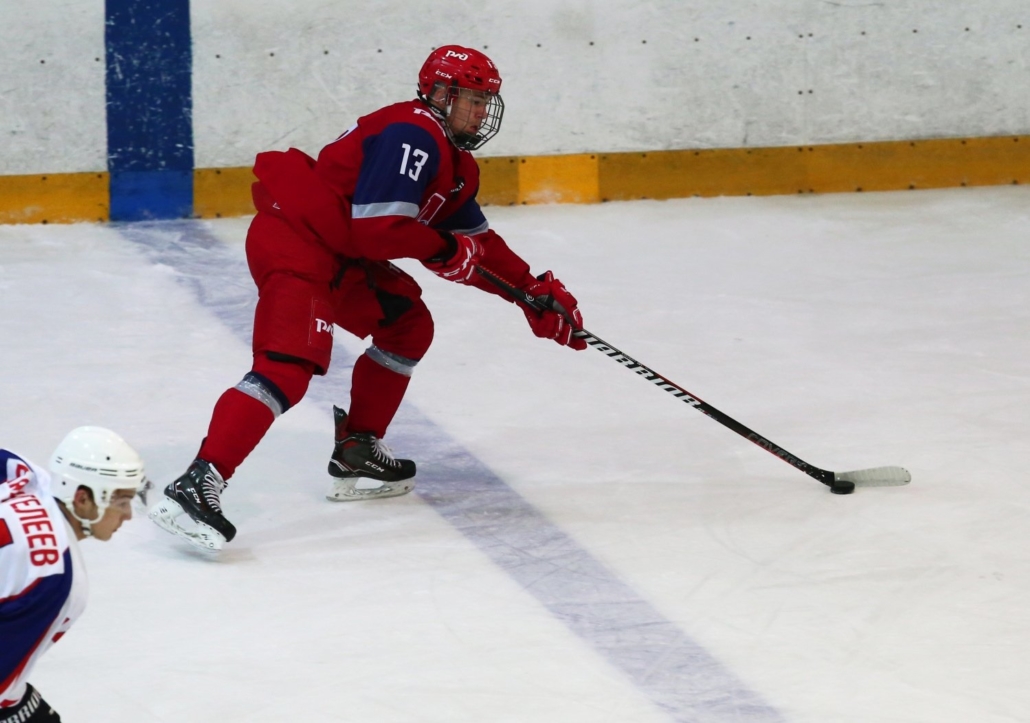
A sturdy, versatile forward with two-way and playmaking capabilities, Tyutnev is one of many under-18 notables who has competed for Russia at all of their key tournaments the last two years who also belongs to a premier organization with playing time at a premium. He was a top-line winger for Russia at both of their gold-medal winning events in 2019-20 — the under-18 Ivan Hlinka in August and the under-20 World Junior “A” Challenge in December — and he played alongside center Vasily Ponomaryov and winger Alexander Pashin at both tournaments. In league play, Tyutnev bounced around from line to line and from role to role on Loko Yaroslavl, playing anywhere from six or seven minutes a game as a bottom-six center to 18 to 20 minutes as a top-line winger. With 13 goals on only 53 shots for a 24.5 shooting percentage, there is no doubt that Tyutnev is earmarked for an expanded role for the entirety of next season.
The highlights of Tyutnev’s game span across all three zones. Like most Russians on both his club and national teams, Tyutnev is extremely well balanced on his skates and is difficult to fix from his desired avenue of approach. He moves laterally with as much quickness and power as he does when moving forward, but he keeps his head up and looks to limit the amount of times he needlessly cedes possession, specifically once he reaches the opposing line. Once he’s inside the zone, Tyutnev is a horse along the boards and a bull behind the net. He’s able to stay under control with more than one defender draped over him, and he reacts and positions himself properly during the cycle. On the power play, Tyutnev is more than proficient at zipping accurate cross-ice or cross-crease passes from the wall, but he also moves near the goal and establishes net-front superiority. His better scoring opportunities generally come via hard work and proper anticipation than simply letting his linemates do the work for him.
One of the most impressive aspects of Tyutnev’s game is his wrist shot. The puck not only explodes off his stick and is usually labeled, but he has soft hands to settle passes of all kinds, and inside a small window of opportunity. Tyutnev handles pucks cleanly on his backhand while moving up ice, and goalies need to concern themselves with a hard, off-wing attempt that is targeted low and to the far post. He can make plays at top speed and using sharp directional changes while altering the angle of his shot attempt.
Tyutnev is an aggressive checker with deceptive speed and quick reaction timing. Once he commits to a target, Tyutnev will not only put his all into the forecheck, but also take the shortest routes available before using his body to separate an opponent from the puck. He was used on the penalty kill with regularity more at the international level than with Lokomotiv, but he should still be considered a trustworthy special teams option for the manner in which he presses the points and keeps his stick active, even at the end of a long kill.
#WJAC: Pavel Tyutnev with an absolute dart, and in a casual 1-on-2 no less. Skorpik should have had this, but sound decision making by a very smart forward. Nothing fancy. Nothing lazy. Nothing safe. Get that goalie moving laterally and exploit that screen.@russiahockey_en pic.twitter.com/xR3dbUlMPo
— Steve Kournianos (@TheDraftAnalyst) December 15, 2019
8. Dmitry Zlodeyev
Center | MHK Dynamo, MHL | 5’11, 185 | 2/15/02 | Shoots Left | 42gp-12g-16a-28pts
Photo: Ari-Matti Ruuska

Zlodeyev is as complete a two-way center as you’ll find. He’s a quick, upright skater with timely bursts into open ice, but there’s a significant level of violence to the way he moves; almost like a tiger increasing its rate of speed as it locks in on its prey. Zlodeyev is a big hitter and puts opposing defensemen on notice once they collect the puck with him bearing down on them. Not only can he run the power play from the half wall, but also anchor the top penalty-killing unit and win almost 57 percent of his faceoffs.
He’s been a top-six center alongside the likes of wingers Bogdan Trineyev and Ivan Didkovskiy at both the national and club level, and the chemistry they share is obvious from the moment they hit the ice. Both are physical players, but most of the possessions inside the opposing end rely on Zlodeyev’s expert puck control and protection. Additionally, it’s Zlodeyev’s quick stick, high motor, and strong desire to separate opponents from the puck that helps his line keep the ice tilted in their favor.
Zlodeyev can be an absolute shark in the neutral zone and reacts to puck travel extremely well. His anticipation and aggressiveness combine to present significant problems for opposing defenders trying to execute a clean breakout, but Zlodeyev’s physical component adds a whole new paint job on things. He can deliver bone-crunching hits, even if it means vacating a spot on his side of the ice and ending up on the other. Compounding things even more is his quick-strike mentality, and the familiarity he has with Trineyev results in multiple odd-man chances or clean zone entries that result in a quality scoring chance.
Skating is not an area of concern for Zlodeyev, who has agility and a quick first step that helps him gain significant separation in open ice. He plays with his head up; usually in search of a trailer or cutter, and he’ll peel back from pressure and allow the situation to clear up rather than force plays or take a low-percentage shot. Zlodeyev is more of a playmaker than he is as a shooter, and wingers like Trineyev and Ivan Didkovskiy get passes perfectly teed up for them to blast on net.
🚨 Дмитрий Злодеев не разбрасывается такими пасами. 2:1 в матче #RUSFIN на #HlinkaGretzkyCup pic.twitter.com/uDhVFVVmWx
— Хоккей России (@russiahockey) August 9, 2019
9. Yan Kuznetsov
Defenseman | UConn, HE | 6’4, 209 | 3/9/02 | Shoots Left | 34gp-2g-9a-11pts
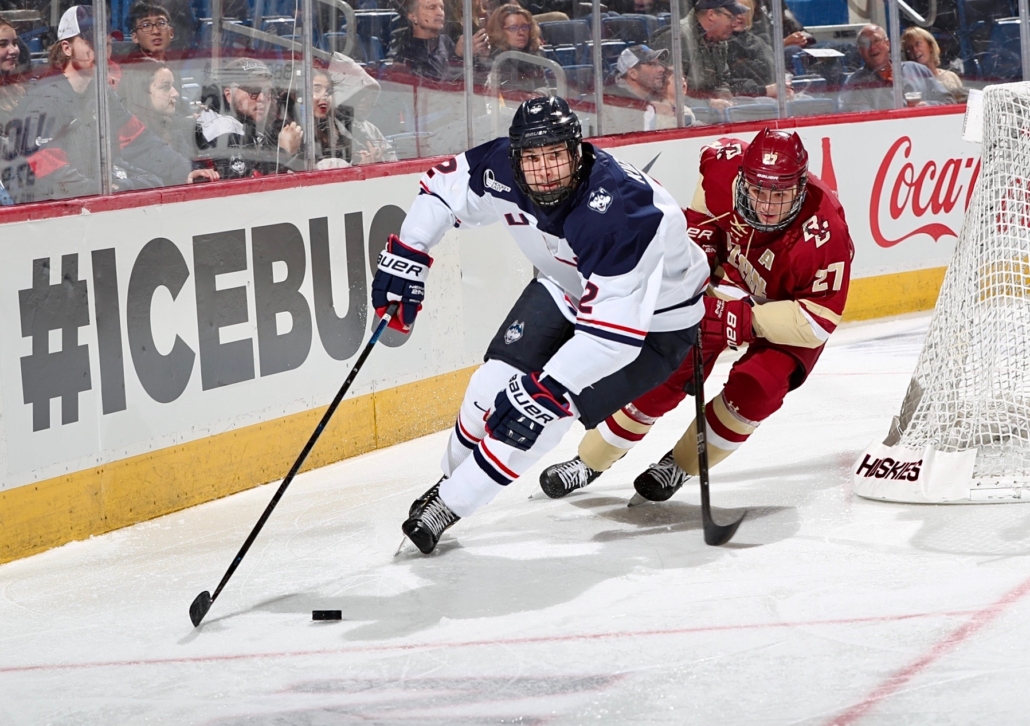
A big, rangy defender with physicality who covers a lot of ground with fluid movements in all directions, Kuznetsov is a bit of a rarity as he’s a first-year draft eligible playing in the NCAA who isn’t a late birthday. After familiarizing himself with the North American game as a depth defender with the USHL’s Sioux Falls Stampede, Kuznetsov has seamlessly transitioned to Hockey East, where he is one of the top scoring freshman defenders in the conference. His biggest contribution on offense comes in the form of joining the rush and unleashing a heavy and accurate shot, but Kuznetsov also goes end to end thanks to a clean, powerful stride and impressive acceleration. His vision, creativity and pass accuracy are average, but he’s good at eluding pressure and playing keep-away long enough until forward support arrives.
Kuznetsov is not a classic power-play quarterback, but his mobility, handling of tough passes, and howitzer from the point can help any team during the man advantage. Kuznetsov is a cerebral teenager without the puck and has the potential to be a high-impact player on defense, and he can be deployed to clear the crease, disrupt opposing cycles, and keep lines of sight clear for his goalies. He normally is very good at defending the rush, and is composed and decisive in one-on-one situations. Kuznetsov also excels at breaking up entry attempts outside his own line, and his speed and reach allows him to loosen his gap rather than misjudge the oncoming puck carrier’s speed. There’s no longer a rawness about his puck skills, as his hands are quite soft, plus his agility and speed for a defender his size is enough of a foundation to build on.
10. Ivan Didkovskiy
Right Wing | MHK Dynamo, MHL | 5’11, 187 | 1/20/02 | Shoots Left | 37gp-20g-13a-33pts

A quick and physical two-way winger who looks to mash the first opponent he marks in his search radius, Didkovskiy combines a tough-as-nails approach with impressive puck skills to be considered one of the draft’s most pugnacious forwards available. Not only is Didkovskiy a lethal goal scorer blessed with a plus-plus shot, but he also is leaned on for tough defensive-zone situations, penalty killing, and assignments that seem to be designed to throw a top opponent off his game.
Being an in-your-face winger who hits hard and plays with an edge doesn’t limit Didkovskiy’s effectiveness in other areas. He has very quick hands and a soft touch that allows him to stickhandle through traffic and dominate the puck in the possession game. He has been used as a go-to option on the power play, primarily as the shoot-first winger looking to fire off the pass. Didkovskiy’s overall skating is average in terms of speed and first-step quickness but he has a low center of gravity that makes him difficult to knock off the puck. He is also strong on his edges and can angle his body low to the ground as he traverses arounds the net or moves laterally along the line. Didkovskiy averaged over four shots a game while playing close to 17 minutes a match.
Off the puck, Didkovskiy is a relentless forechecker who uses his assertiveness and quickness to deliver massive hits. His efforts while down a man are just as tireless and pressing the points doesn’t only mean being up in a defender’s face — Didkovskiy will shove him hard and even look to deliver a big bodycheck. Sometimes this can get him into trouble by overcommitting, and opponents seem fully aware of his reputation. As the season progressed, however, Didkovskiy appeared to make some adjustments and opt for a more controlled aggression rather than charge in an unbridled, erratic fashion that can leave him in the dust.
RW Ivan Didkovskiy (Ranked No. 114) with a hard-earned PP goal in Dynamo Moscow’s 2-1 loss to Tayfun. He was one of Russia’s top players at a recent under-18 showcase in the Czech Republic, using physicality and quickness…
📸 https://t.co/0nqC46c8XN via https://t.co/r0OWBqxU5A pic.twitter.com/hJLSKDMXIF
— Steve Kournianos (@TheDraftAnalyst) October 30, 2019
